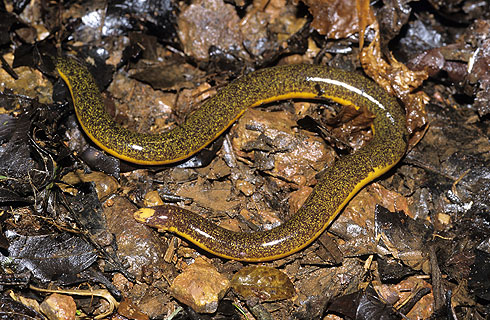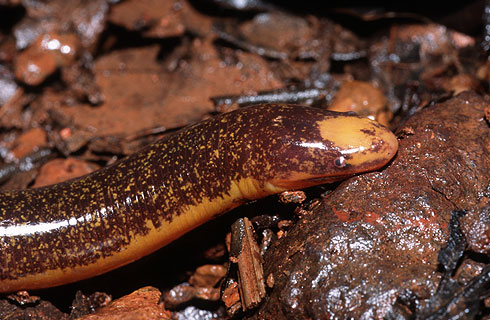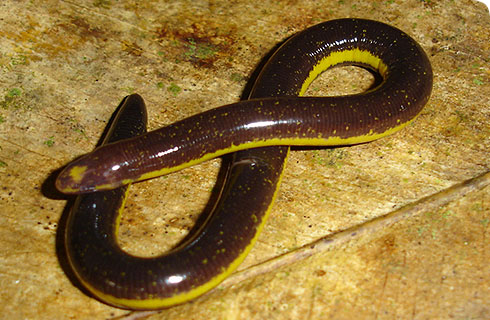Rhinatrema bivittatum (two-lined caecilian)
Rhinatrema bivittatum is the type species of Rhinatrema, which is the type genus of the Rhinatrematidae - the sister group to all other caecilians.
Rhinatrematids - like Rhinatrema bivittatum - retain more ancestral features than other caecilian amphibians. This makes them important in studies of the ancestry and early evolution of caecilians.
By analysing differences in DNA sequences, scientists have discovered that Rhinatrematids probably branched off from all other living caecilians about 215 million years ago (San Mauro et al 2005; Roelants et al 2007; San Mauro 2010).
Species detail
Rhinatrema bivittatum is a medium-sized caecilian. It is approximately 20cm long and has:
- a distinct tail
- an open space between squamosal and frontal bones in the skull - a zygokrotaphic skull
- yellow lateral stripes along the body
- a distinct yellow spot on the dorsal surface of both the snout and tail
-

Taxonomy
Until 2010, Rhinatrema bivattatum was the only species of Rhinatrema known. But a new species has now been described. Find out where it was found and what distinguishes it from Rhinatrema bivattatum.
-

Distribution
Rhinatrema bivittatum lives in South America, mainly in Brazil and French Guiana.
-

Biology
Rhinatrema bivittatum lives in moist soil and leaf litter where it burrows for food. Find out what it likes to eat.
-

Conservation
Little is known about the population status of Rhinatrema bivittatum and its relatives. Find out what we do know.
-

References
Get more information on Rhinatrema bivittatum.
Images

Adult specimen of Rhinatrema bivittatum from French Guiana.
© Peter Stafford
Collecting Rhinatrema bivittatum in French Guiana. Like many terrestrial caecilians, Rhinatrema bivittatum can be collected by digging in moist soil, for example around rotten logs.
© Diego San Mauro
Rhinatrema bivittatum.
© Jean-Pierre Vacher
Rhinatrema bivittatum.
© Jean-Pierre VacherAbout the author
Diego San Mauro
Former Marie Curie Post-Doctoral Fellow
Department of Zoology
Toolbox
Glossary
Squamosal
A plate-like bone in the skull of vertebrates.
